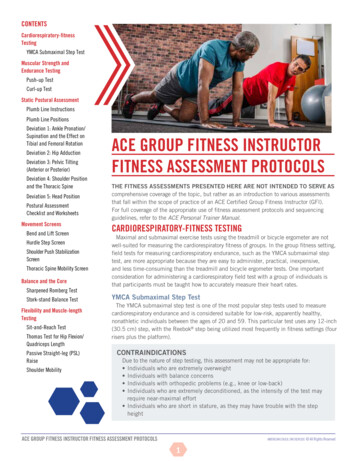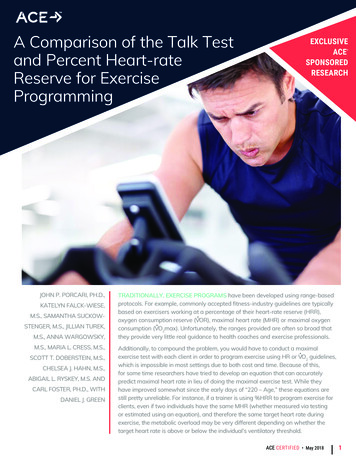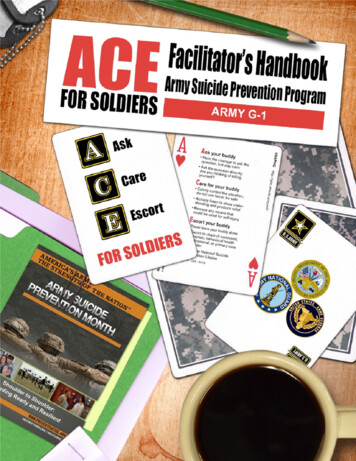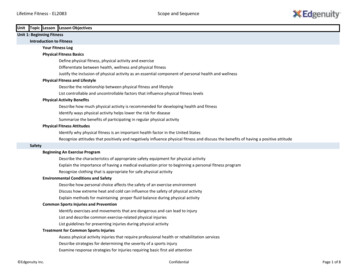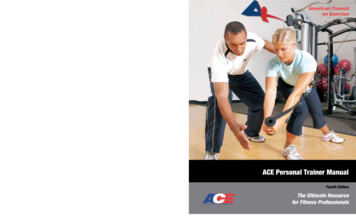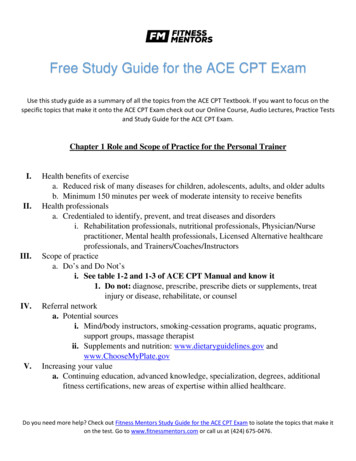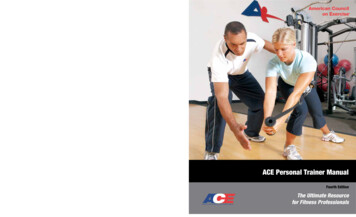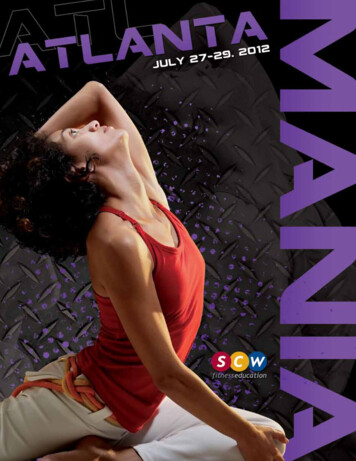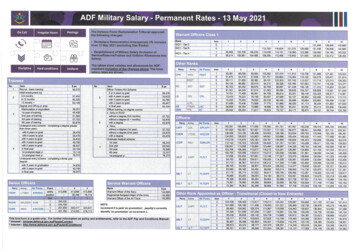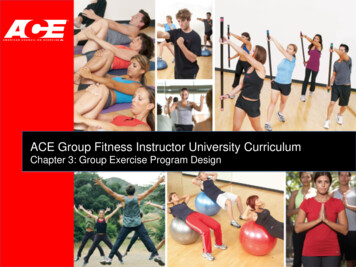
Transcription
ACE Group Fitness Instructor University CurriculumChapter 3: Group Exercise Program Design
Learning Objectives Upon completion of this chapter, you willbe able to: Explain general group exerciserecommendations for healthy adults Determine the difference between studentcentered and teacher-centered instruction Identify the principles of a safe and effectivewarm-up Design a safe and effective cardiorespiratorysegment Program safe and effective exercises for amuscular strength and endurance segment Offer safe and effective choices for improvingrange of motion (ROM) in a flexibility segment
Introduction Today, group exercise program designpotentially involves: Empowering people with the ability to improvetheir quality of life Expanding participants’ social engagement byconnecting them with others Individuals who participate in physicalactivity for enjoyment and to achieve goalsare more likely to have better self-efficacy. Social support contributes to motivation for,and adherence to, physical activity.
General Group ExerciseRecommendations for Healthy Adults American College of Sports Medicine(ACSM, 2010) exercise programmingguidelines for healthy adults include: FrequencyIntensityTime (duration) or repetitionsType (activity) A table of these recommendations ispresented on the next slide. Guidelines and appropriate group exercisedesign help promote physical activity.
General Exercise Recommendations forHealthy Adults
ACE Integrated Fitness TrainingTM Model A model for exercise program design developed to guidepersonal trainersGFIs can apply the core concepts of the model in a groupfitness setting.The ACE Integrated Fitness Training (ACE-IFTTM) Modelconsists of two components, each of which is divided into fourphases. The two components are functional movement andresistance training and cardiorespiratory training. Rapport is the foundation for success throughout themodel.A table that describes the ACE-IFT model is presented on thefollowing slide.
ACE-IFT Model–Training Components and Phases
Group ExerciseProfessionalism and Attitude Safe and effective group exercise instructionrequires a high level of effort and a positiveattitude on the part of the GFI. Leaders with a positive mood transfer theirpositive attitude to the group members. For long-term participant adherence, a GFIshould focus on the health- and enjoymentrelated factors of exercise.
Student-centered Instruction Student-centered instruction enhances participants’interests and addresses their needs. Teacher-centered instruction does not create an idealenvironment for participants, as it fosters: DependenceIntimidationUnattainable goalsQuick fixes The student-centered instructor strives to establishan atmosphere of: IndependenceEncouragementAttainable goalsRealism
Additional GFI Leadership Styles Visionary Inspires by articulating a heart-felt shared goaland then giving feedback about progress towardthe goal Coaching Addresses an individual’s personal aspirations byasking him or her what they are and thenprovides feedback as the individual moves towardthe goal Democratic Draws on what others in the group know to makebetter decisions for the group as a whole Affiliative Builds emotional capital and harmony throughhaving fun together
Creating a HealthyEmotional Environment Enjoyment during exercise is optimizedwhen a positive and supportive leadershipstyle is coupled with a supportiveenvironment. To tap into participants’ positive emotions,GFIs should: Greet participants by name as they enter theroom Use positive words and expressions Move around the room and interact withparticipants Wear a variety of exercise clothing Encourage participants to use mirrors as a formof exercise technique feedback rather than a wayto judge themselves
Class Format The major considerations for most group fitnessclasses are: Warm-upCardiorespiratory exerciseMuscular strength and endurance trainingFlexibility exercise/cool-down Regardless of the specific class format, offering avariety of options and not being restricted to a typical60-minute class duration is likely to meet morepeople’s health goals.
Warm-up Appropriate dynamic movement in thewarm-up: Raises internal body temperature Allows important physiological reactions to takeplace May reduce the risk of injury Rehearsal moves allow participants topractice movement, which leads to success. If static stretches are included, they shouldbe performed after temperature elevation.
Cardiorespiratory Segment GFIs can promote independence and selfresponsibility. Encourage participants to work at their own pace. Gradually increasing intensity is necessary tofacilitate important physiological reactions. Blood flow redistribution Heart rhythm adaptations Respiratory changes GFIs can reach participants of all fitness levels byoffering intensity and/or impact options.
Cardiorespiratory Segment Building sequences can be included whenteaching complex movements. A variety of muscle groups can be targetedto balance muscles used in other dailyactivities. Enjoyment of exercise is enhanced whenmusic selection matches participants’interests. A post-cardio cool-down segment should beincluded. Stretching can also be added during thissegment.
Adding Weight to aCardiorespiratory Workout The use of 1- to 3-lb weights can increaseexercise heart rate (HR) by five to 10 bpm. Weights greater than 3 lb are notrecommended. Wrists weights are preferred over hand-heldweights. The beneficial effect of using ankle weightsis lower than upper-extremity weights. The use of ankle weights is not recommended. The use of weighted vests during exercisecan be beneficial. The weight of the vest should not exceed 5–10%of the participant’s body weight.
Muscular Strength andEndurance Segment The GFI’s focus should be on achievingmuscle balance. Helps to promote functional fitness The GFI must demonstrate proper form andthen teach it to individual participants. Giving appropriate cues is one of the mostimportant aspects of the muscular strengthand endurance segment. Verbal Visual Physical
Muscular Strength andEndurance Segment Resistance-training equipment can be usedto provide muscle overload and a funenvironment. The key is to individualize exercises for variousability levels. Music and exceptional cueing can be usedto create an effective instructionalatmosphere.
Flexibility Segment It is important to stretch muscle groups that: Have been used in the group exercise activity Are commonly tight Stretching should becomfortable forparticipants. Stretching to the point ofshaking should bediscouraged. Invoking the stretch reflexthrough ballistic stretchingshould be avoided. Relaxation and visualization can be usedduring the flexibility segment.
Summary This chapter covered: General group exercise recommendations forhealthy adults The difference between student-centered andteacher-centered instruction Principles of a safe and effective warm-up Designing a safe and effective cardiorespiratorysegment Programming safe and effective exercises for themuscular strength and endurance segment Offering safe and effective choices for improvingrange of motion (ROM) in a flexibility segment
Group Exercise Professionalism and Attitude Safe and effective group exercise instruction requires a high level of effort and a positive attitude on the part of the GFI. Leaders with a positive mood transfer their positive attitude to the group members. For long-term participant adherence, a GFI should focus on the health- and enjoyment-
